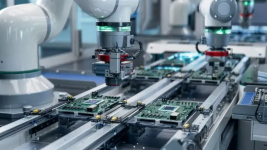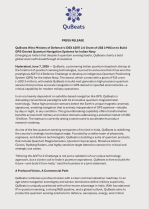Ministry of Defence
DRDO & IIT Delhi demonstrate Quantum Entanglement-Based Free-Space Quantum Secure Communication over more than 1 km distance
Paves way for development in quantum cyber security, quantum networks & future quantum internet
India has entered into a new quantum era of secure communication which will be a game changer in future warfare: Raksha Mantri
Posted On: 16 JUN 2025 5:18PM by PIB Delhi
View attachment 44518
India has entered into a new quantum era by successfully demonstrating an experimental advancement through DRDO-Industry-Academia Centre of Excellence (DIA-CoE), IIT Delhi. The free-space quantum secure communication using quantum entanglement over a distance of more than one km was achieved via a free-space optical link established on the IIT Delhi campus.
The experiment attained a secure key rate of nearly 240 bits per second with a quantum bit error rate of less than 7%. This entanglement-assisted quantum secure communication paves the way for real-time applications in quantum cyber security, including long-distance Quantum Key Distribution (QKD), the development of quantum networks, and the future quantum internet. These efforts align with India’s broader objectives to advance quantum technologies for national development.
Under the project ‘Design and development of photonic technologies for free space QKD’, sanctioned by Directorate of Futuristic Technology Management (DFTM), DRDO, the demonstration was given by Prof Bhaskar Kanseri’s research group in the presence of several dignitaries, including the DRDO DG (MED, COS & CS), Director SAG, Director DFTM, Dean (R&D) IIT Delhi, Director (DIA-CoE) and DRDO laboratory scientists.
Quantum entanglement-based QKD offers several significant advantages over the traditional prepare-and-measure method by enhancing both security and functionality. Even if devices are compromised or imperfect, the use of quantum entanglement ensures the security of key distribution. Any attempt to measure or intercept the entangled photons disturbs the quantum state, allowing authorised users to detect the presence of an eavesdropper.
Quantum communication provides fundamentally unbreakable encryption, making it a dual-use technology with applications in securing data in strategic sectors such as defence, finance, and telecommunications, as well as in protecting national security-related communications. Free-space QKD eliminates the need to lay optical fibers, which can be both disruptive and expensive, especially in challenging terrains and dense urban environments.
Earlier, India’s first intercity quantum communication link between Vindhyachal and Prayagraj in 2022, using commercial-grade underground dark optical fiber was demonstrated by DRDO scientists along with Prof Bhaskar’s team. More recently, in 2024, the team successfully distributed quantum keys using entanglement over a 100 km spool of telecom-grade optical fiber in another DRDO-supported project.
These technologies are being developed through DRDO-Industry-Academia – Centres of Excellence (DIA-CoEs) – an initiative of DRDO, where 15 Centres of Excellence have been established at premier academic institutes like IITs, IISc & Universities for development of cutting-edge defence technologies.
Raksha Mantri Shri Rajnath Singh has congratulated DRDO & IIT Delhi for this landmark achievement, stating that India entered into a new quantum era of secure communication which will be a game changer in future warfare.
Secretary Department of Defence R&D and Chairman DRDO Dr Samir V Kamat and Director, IIT Delhi Prof Rangan Banerjee congratulated the team for these key achievements.
https://www.pib.gov.in/PressReleasePage.aspx?PRID=2136702









